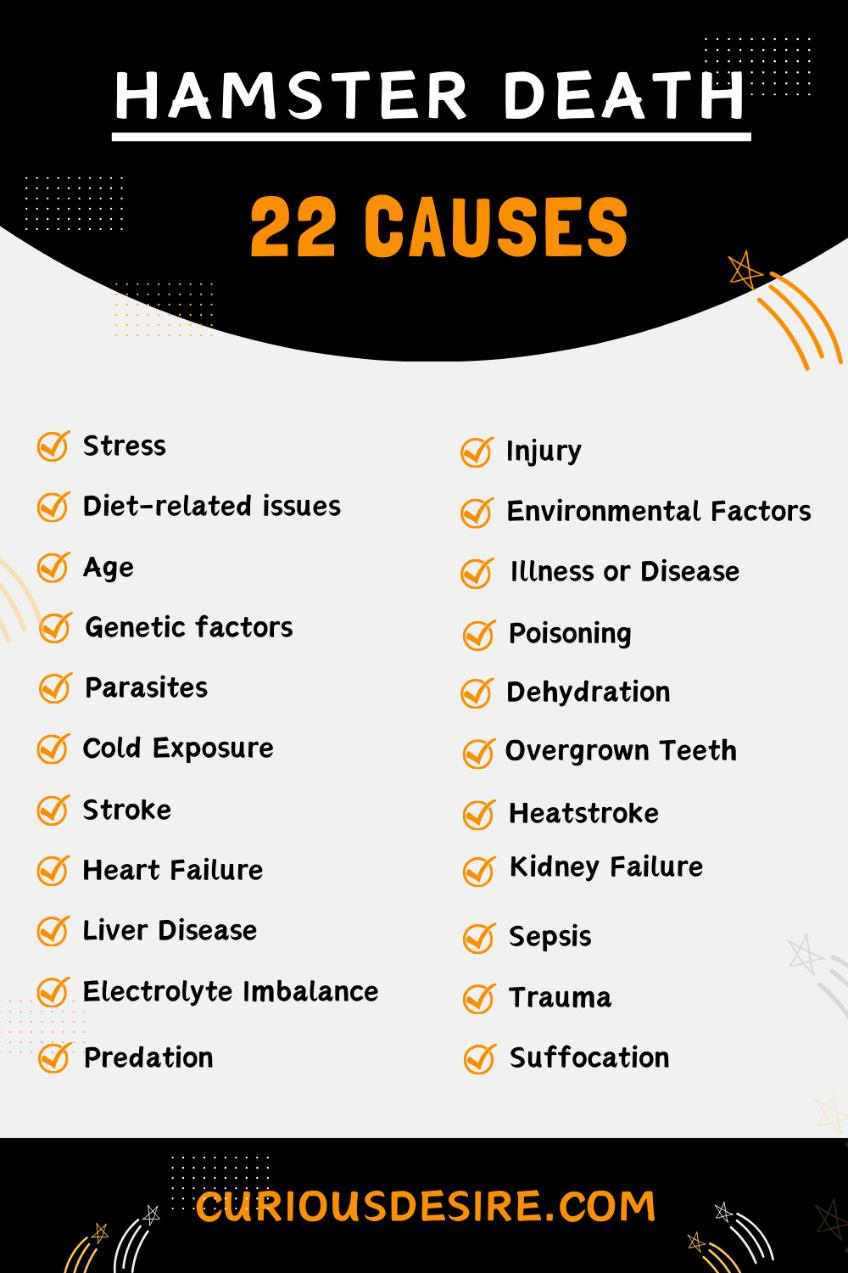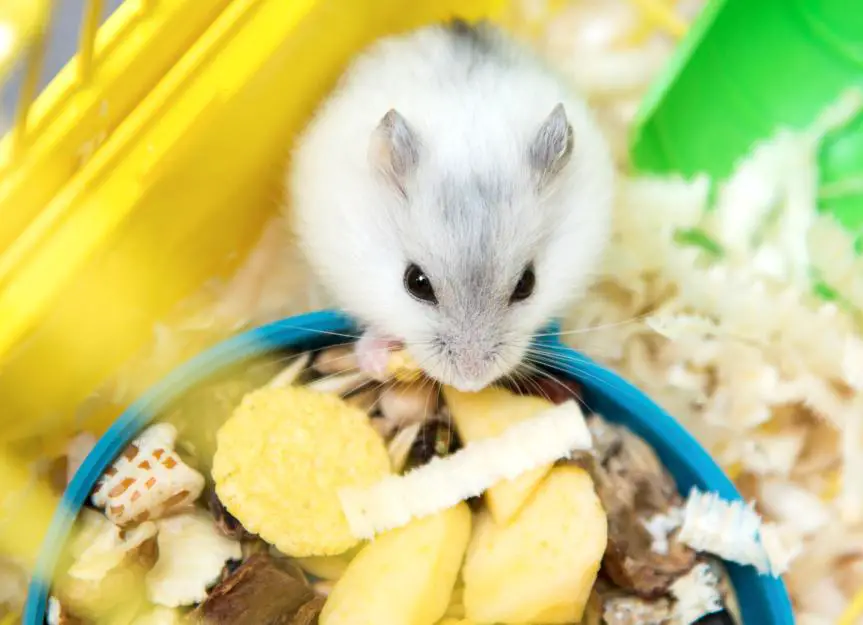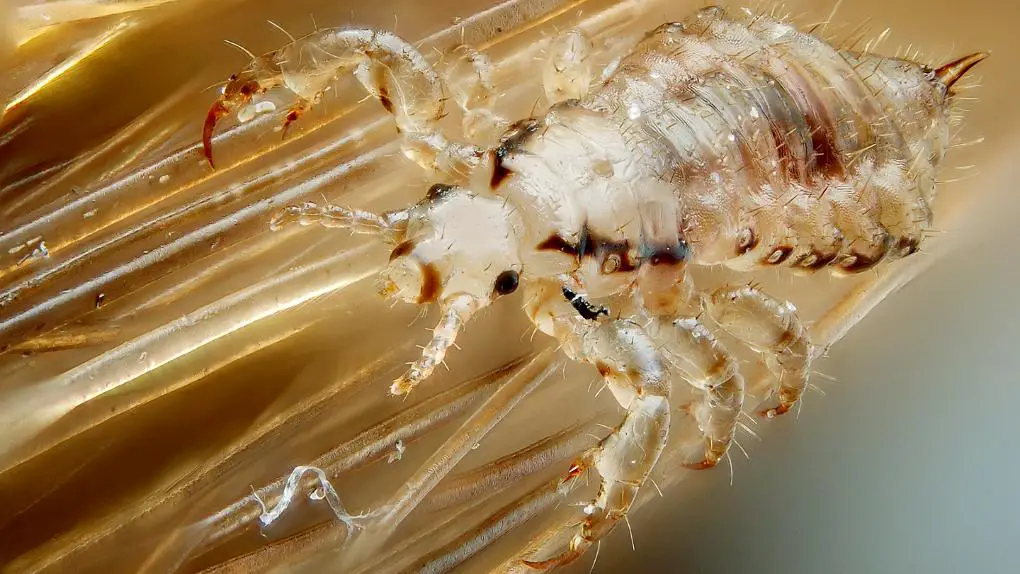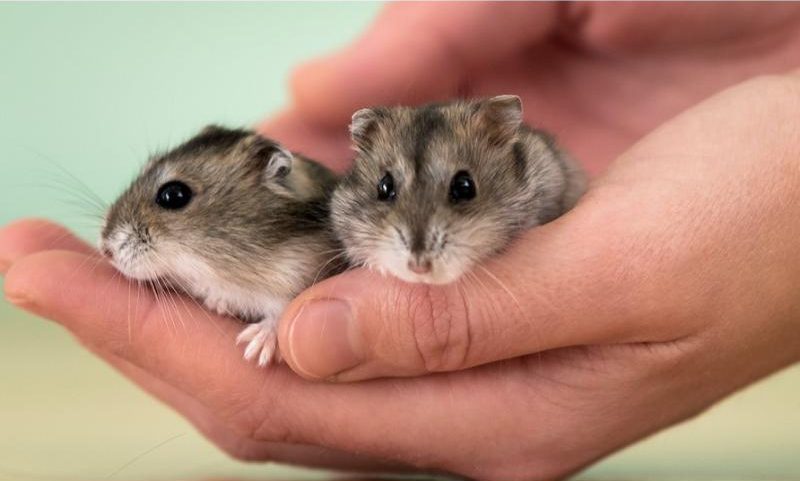Hamsters, beloved for their adorable nature and low-maintenance care, are popular pets for many households.
However, like any living creature, hamsters are susceptible to various health issues that can lead to premature death.
Understanding the potential causes of hamster death is crucial for providing proper care and ensuring the well-being of these small companions.
In this discussion, our focus will be on the causes of hamster death, shedding light on the importance of proactive care and attentive monitoring for these beloved pets.
Here are the top 5 causes of Hamster death:
- Diet-related issues
- Illness or Disease
- Poisoning
- Stroke
- Sepsis
[toc]

1. Stress
Hamsters are sensitive animals, and stress can weaken their immune systems, making them more vulnerable to illnesses.
Stressors such as improper handling, loud noises, sudden environmental changes, inadequate cage size, or aggression from other hamsters can significantly impact their health and potentially lead to death.
2. Injury
Hamsters are prone to injuries from falls, getting caught in cage accessories, or being mishandled.
Even seemingly minor injuries can escalate quickly, leading to severe health complications or death if not addressed promptly.
3. Diet-related issues
Providing a balanced diet is crucial for hamsters’ health. Inappropriate diets or sudden changes in diet can lead to digestive problems, malnutrition, and ultimately death.
It’s essential to feed hamsters a variety of fresh vegetables, fruits, grains, and commercial hamster food to ensure they receive the necessary nutrients.
4. Environmental factors
Extreme temperatures, drafts, or poor ventilation in a hamster’s environment can cause stress and contribute to health problems such as respiratory issues or heatstroke, which can be fatal if left untreated.
Maintaining a comfortable and stable environment is vital for the well-being of pet hamsters.
5. Age
Hamsters typically live for around 1.5 to 3 years, depending on the species.
As they age, their bodies become more susceptible to various health issues, and natural death due to old age becomes increasingly common.
6. Illness or Disease
Hamsters can suffer from a range of illnesses, including respiratory infections, wet tails (a bacterial infection common in young hamsters), tumors, diabetes, and digestive issues.
Without prompt veterinary treatment, these illnesses can progress and ultimately lead to death.
7. Genetic factors
Some hamsters may inherit genetic predispositions to certain health issues, such as cardiovascular problems, neurological disorders, or susceptibility to infections, which can lead to premature death.
While genetic factors are beyond an owner’s control, providing proper care and monitoring for any signs of illness can help manage these risks.
8. Poisoning
Hamsters are curious creatures and may accidentally ingest toxic substances such as pesticides, certain houseplants, or household chemicals.
Poisoning can lead to severe health complications or death, highlighting the importance of keeping harmful substances out of reach and providing a safe environment for hamsters to explore.
9. Parasites
External parasites like mites or internal parasites such as worms can cause discomfort, malnutrition, and even organ damage in hamsters if left untreated.
Regular veterinary check-ups and preventative measures, such as maintaining cleanliness in the hamster’s environment, are essential for preventing parasite infestations.
10. Dehydration
Hamsters require access to clean water at all times to stay hydrated.
Dehydration can occur due to inadequate water supply or underlying health issues preventing the hamster from drinking.
It’s crucial to monitor water intake and seek veterinary attention if signs of dehydration, such as sunken eyes or lethargy, are observed.
11. Cold Exposure
Similarly, exposure to extreme cold without sufficient bedding or warmth sources can lead to hypothermia in hamsters.
Signs of hypothermia include
- Shivering
- Lethargy
- Cold to the touch
Providing extra bedding, and nesting material, and relocating the cage to a warmer area can help prevent cold-related health issues.
12. Overgrown Teeth
Hamsters’ teeth continually grow throughout their lives, and if not worn down through chewing or genetic factors, they can become overgrown, leading to difficulty eating and potential starvation.
Providing chew toys, wooden blocks, or mineral chews can help keep hamsters’ teeth properly trimmed.
13. Stroke
Like humans, hamsters can suffer from strokes, which occur when blood flow to the brain is disrupted, leading to sudden neurological symptoms such as paralysis or loss of coordination.
Strokes can be fatal or result in long-term disabilities, highlighting the importance of monitoring hamsters for any signs of neurological issues and seeking veterinary care promptly.
14. Heatstroke
Hamsters are sensitive to high temperatures and can quickly succumb to heatstroke if exposed to excessively hot environments without access to cooling mechanisms.
Signs of heatstroke include
- Rapid breathing
- Lethargy
- Weakness
Providing shade, adequate ventilation, and cooling options such as ceramic tiles or frozen water bottles can help prevent heat-related illness.
15. Heart Failure
Cardiovascular issues, including heart failure, can occur in hamsters, especially as they age.
Symptoms of heart failure may include
- Lethargy
- Difficulty breathing
- Fluid accumulation in the abdomen
While treatment options for heart conditions in hamsters are limited, supportive care and symptom management can help improve their quality of life.
16. Kidney Failure
Chronic kidney disease or acute kidney failure can occur in hamsters due to factors such as aging, genetic predisposition, or underlying health conditions.
Signs of kidney failure may include
- Increased thirst
- Frequent urination
- Weight loss
While kidney failure in hamsters is challenging to treat, supportive care such as fluid therapy and dietary modifications may help manage symptoms and slow disease progression.
17. Liver Disease
Liver issues such as fatty liver disease or liver failure can occur in hamsters due to factors such as obesity, poor diet, or exposure to toxins.
Symptoms of liver disease may include
- Jaundice
- Lethargy
- Loss of appetite
Treatment for liver conditions in hamsters typically involves addressing underlying causes, supportive care, and dietary changes to reduce stress on the liver.
18. Sepsis
Severe infections that spread throughout the body can lead to sepsis, a life-threatening condition characterized by systemic inflammation and organ dysfunction.
Hamsters with sepsis may exhibit symptoms such as
- Fever
- Lethargy
- Rapid breathing
Prompt veterinary intervention, including aggressive antibiotic therapy and supportive care, is crucial for improving the chances of survival in hamsters with sepsis.
19. Electrolyte Imbalance
Disturbances in electrolyte balance, such as low potassium or sodium levels, can occur in hamsters due to factors such as dehydration, kidney disease, or metabolic imbalances.
Electrolyte imbalances can lead to serious health complications, including
- Cardiac arrhythmias
- Neurological symptoms
Treatment may involve fluid therapy and correcting underlying causes to restore electrolyte balance.
20. Trauma
Accidents, such as being dropped or stepped on, can cause severe injuries or internal damage in hamsters.
Common injuries may include broken bones, internal bleeding, or organ rupture.
It’s essential to handle hamsters gently and provide a safe environment free of hazards to prevent traumatic injuries.
21. Predation
Hamsters housed outdoors or allowed to roam freely may be at risk of predation by animals such as cats, dogs, or birds.
Predators can cause severe injuries or kill hamsters, emphasizing the importance of providing secure enclosures and supervising outdoor playtime.
22. Suffocation
Accidental entrapment in cage accessories or bedding material can lead to suffocation and death in hamsters.
Owners should regularly inspect cage furnishings for any potential hazards and provide appropriate bedding materials to prevent suffocation risks.
Hamster Death Causes FAQs
1. Why did my hamster suddenly die?
Hamsters can suddenly die due to various reasons, including illness, injury, old age, or stress.
It’s essential to consider factors such as the hamster’s age, behavior, and any recent changes in its environment or health to understand the cause of death.
If you’re concerned about your hamster’s sudden death, consulting with a veterinarian can provide insights and help you understand what might have happened.
2. What are the most common deaths for hamsters?
The most common causes of death for hamsters include illness or disease (such as respiratory infections, tumors, or wet tails), old age, stress-related complications, and accidents.
Providing proper care, a suitable environment and regular veterinary check-ups can help minimize the risk of these common causes of death and prolong your hamster’s lifespan.
3. How do you know if a hamster is dying?
Signs that a hamster may be dying include lethargy, decreased appetite, difficulty breathing, hunched posture, and cold extremities.
Additionally, you may notice behavioral changes such as increased hiding or reduced interaction with the environment.
If you suspect your hamster is dying, it’s essential to provide comfort and consider seeking veterinary care to assess the situation and provide appropriate support.
4. Can hamsters die from a dirty cage?
A dirty cage can contribute to health problems for hamsters, but it’s unlikely to directly cause death unless the hygiene issues lead to severe infections or respiratory problems.
Regular cage cleaning is essential to maintain your hamster’s health and well-being, as dirty bedding can harbor bacteria and parasites that may compromise their immune system and overall health.
5. Can hamsters die naturally?
Yes, hamsters can die naturally due to old age. The average lifespan of a hamster ranges from 1.5 to 3 years, depending on the species and individual health factors.
As hamsters age, their bodies become more susceptible to various health issues, and natural death due to old age becomes increasingly common.
6. What to do when a hamster dies?
When a hamster dies, it’s essential to handle the situation with care and respect.
You can gently remove the hamster from its cage and consider burying it in a suitable location or opting for cremation.
Providing a small memorial or saying a few words can help you cope with the loss.
Additionally, it’s crucial to clean and disinfect the cage and accessories to prevent the spread of any potential diseases.
7. What is poisonous to a hamster?
Several substances are toxic to hamsters and should be kept out of their reach, including chocolate, caffeine, onions, garlic, alcohol, avocado, and certain houseplants such as ivy, philodendron, and azaleas.
Additionally, household cleaners, pesticides, and rodent poisons can be harmful if ingested by hamsters. It’s essential to be cautious and keep these items away from your hamster’s environment to ensure their safety.
8. Should I remove the dead baby hamster?
If you discover a dead baby hamster in the cage, it’s essential to remove it promptly to prevent any potential health risks for the remaining hamsters.
You can use gloves or a tissue to carefully remove the body and dispose of it properly.
Additionally, inspect the cage and nesting area for any signs of illness or injury among the other hamsters and monitor them closely for any changes in behavior or health.
9. How long do Syrian hamsters live?
Syrian hamsters, also known as golden hamsters, typically live for about 2 to 3 years, although some may live slightly longer with proper care.
Providing a suitable environment, a balanced diet, and regular veterinary check-ups can help maximize your Syrian hamster’s lifespan.
10. How long can a hamster go without a clean cage?
Hamsters should ideally have their cages cleaned at least once a week to maintain proper hygiene and prevent health issues.
However, if necessary, a hamster can typically go a few days without a cage cleaning as long as they have enough space, fresh bedding, and access to clean water and food.
Regular cage maintenance is essential for your hamster’s health and well-being.
11. Is it OK to clean a hamster cage?
Yes, it’s essential to clean your hamster’s cage regularly to maintain proper hygiene and prevent health problems.
You can use mild soap and warm water to clean the cage, removing any bedding, food debris, or waste. It’s essential to rinse the cage thoroughly and allow it to dry completely before placing your hamster back inside.
Additionally, disinfecting the cage occasionally can help kill any bacteria or parasites that may be present.
12. How do you clean a dirty hamster cage?
To clean a dirty hamster cage, start by removing your hamster and any accessories from the cage.
Dispose of the old bedding and food debris, then wash the cage with mild soap and warm water.
Scrub any stubborn stains or residue, rinse the cage thoroughly, and allow it to dry completely before adding fresh bedding and returning your hamster and its accessories to the cage.
Regular cage cleaning is essential for your hamster’s health and well-being.
13. Are hamsters hard when they die?
When hamsters die, their bodies typically become stiff due to rigor mortis, a natural post-mortem process that occurs in many animals.
This stiffness usually sets in a few hours after death and gradually fades over the following hours or days.
It’s essential to handle a deceased hamster with care and respect, even if their body feels stiff or rigid.


